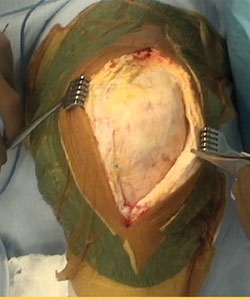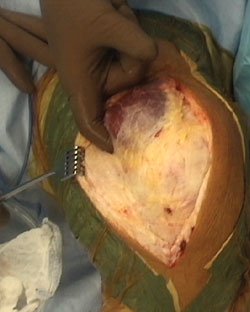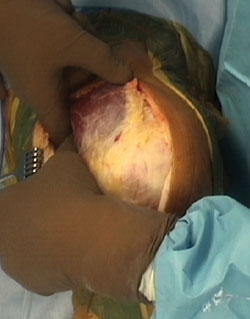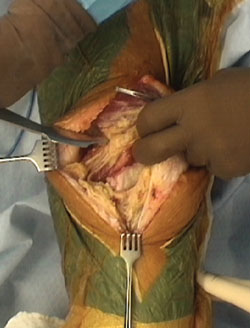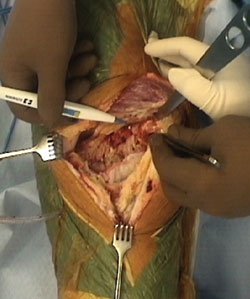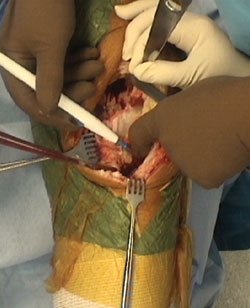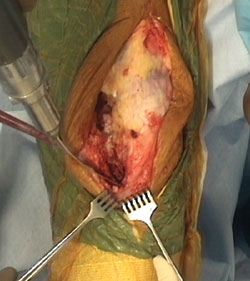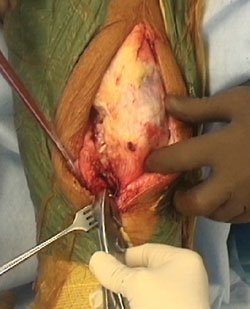Prevent postoperative loss of extension and maximize knee range of motion
Maximizing motion recovery after total knee replacement requires a multimodal strategy, including surgical technique, supportive rehabilitation and aggressive pain control.
My strategy for enhanced recovery begins with the choice of the surgical approach. I use the muscle-sparing or subvastus approach. It has been around a long time; originally described by Erkes in 1929, it first appeared in the U.S. literature in 1945. It uses the plane between the vastus medialis and the intermuscular septum. The approach has been shown to improve rates of recovery in multiple prospective studies.
Some surgeons feel that the exposure is difficult and should not be used in obese patients or men with large quad muscles or a very low riding patella. I have learned several maneuvers during the past 20 years that have made it possible for me to use the approach on all of my primary total knees and most of my revision cases. Here are a few of the tricks that I use.
Preferred incision
|
Images: Mahoney OM |
The preferred incision is midline, extending from 3 or 4 inches above the patella down to the medial aspect of the tibial tubercle, which I make with the knee flexed. The incision can be shortened to an inch or so above the patella, but in these cases, the patella should not be everted as this can result in skin tears. The incision is carried down through the deep fascia, which invests the muscle more intimately over the vastus medialis obliquus (VMO).
I use a knife blade to extend the incision in the fascia several centimeters above the skin incision to allow easy patella eversion without traumatizing the muscle against the taught edge of the intact fascia. The fascia is elevated off the lateral and medial aspects of the vasti beginning with blunt dissection proximally, sweeping distally. Sharp dissection is almost always required over the VMO, and I sometimes extend the knee to facilitate elevation of the layer. It is extremely important to stay below the deep fascia (Figure 1). The anastomotic bed of vessels supplying the skin are just superficial to the deep fascia; so if the surgeon strays above the layer, the blood supply to the skin can be jeopardized.
The release
The next step is to separate the interval between the posterior border of the vastus medialis and the intermuscular septum. The surgeon’s more cephalad index finger is passed under the muscle with the knee bent, and the other hand is used to push the dissecting hand proximally up to 10 centimeters (Figures 2a and 2b). A perforating vessel may be avulsed during this maneuver, so I always drop the tourniquet prior to closure to ensure that the vessel can be easily identified and cauterized.
|
|
|
Next, the capsule is marked so that it can be closed evenly after the procedure. The arthrotomy is made distally to proximal, including a release of the medial patella-femoral ligament. The release is extended proximally onto the anterior medial surface of the femur, so the suprapatellar pouch can be elevated. It is important to stay on the anterior surface of the femur and not stray posterior toward the intermuscular septum because tissue trauma in that area can result in the formation of heterotopic bone, which can tether the muscle belly. A Holmann retractor then can be used like a periosteal elavator to lift the pouch off of the femur (Figures 3a and 3b).
|
|
|
Attention is now turned to the distal end of the capsulotomy where the next important maneuver takes place. The retro patellar bursa must be completely elevated from the proximal tibia so that the patella can be easily everted or dislocated without placing excessive tension on the extensor mechanism. I prefer the cautery for this part of the release because it is done blind, and I find it easier to palpate the bony surface with the blunt cautery tip than with a knife blade. A finger can be used to pull the tendon away from the tibia while the electrocautery tool is used to elevate the soft tissue all the way to the lateral corner of the proximal tibia (Figure 4). Failure to adequately release the bursa can lead to extensor avulsion.
|
|
|
|
A pin is placed into the medial edge of the patellar tendon to help prevent avulsion. I prefer a 0.062 K-wire, which is cut off short and bent twice so that the sharp end is buried in the soft tissue (Figures 5a and b).
Surgical pearls
My keys to the exposure include:
- releasing the deep fascia proximally enough to avoid damage to the vastus muscle;
- releasing the suprapatellar pouch from the anterior femur subperiosteally beginning on the anterior medial edge and extending all the way to the anterior lateral edge of the femur. Do not elevate tissue from the medial bed of the VMO; and
- releasing the retropatellar bursa fully from the anterior tibia. The release should extend all the way to the lateral corner of the tibia. Tight bands of tissue can be palpated with the surgeon’s finger as the cautery tip is used to release any tissue tethering the extensor mechanism.
The approach allows easy exposure to the entire knee joint and even several centimeters of the proximal femur if these technical tips are used. If adequate exposure cannot be obtained, the dissection can be extended via a tibial tubercle osteotomy, as described by Leo A. Whiteside, MD, but I have found this to be necessary in only a handful of cases.
In summary, this approach has been shown to promote a more rapid rate of recovery in multiple prospective studies. Difficulties noted by some surgeons can be addressed by using the tips described here. The key to adequate visualization is achieving maximum mobility of the extensor mechanism so that the only distal attachment is the intact patellar tendon. The approach places minimal tension on the vastus muscle belly while preserving maximum vascularity to the patella.
References:
- Abbott LC, Carpenter WF. Surgical approaches to the knee joint. J Bone Joint Surg Am. 1945; 47:277-310.
- Hanssen, AD. The subvastus approach for total knee arthroplasty resulted in better short-term outcomes than did the parapatellar approach. J Bone Joint Surg Am. 2002; 84(2):325.
- In Y, Kim JM, Choi NY, Kim SJ. Large thigh girth is a relative contraindication for the subvastus approach in primary total knee arthroplasty. J Arthroplasty. 2007; 22(4):569-573.
- Maffulli G, Bridgman S, Maffulli N. Total knee arthoplasty: better short-term results after subvastus approach. Knee Surg Sports Traumatol Arthrosc. 2011; 19(6):1047.
- Schroer, WC, Diesfeld PJ, Reedy ME, LeMarr AR. Mini-subvastus approach for total knee arthroplasty. J Arthroplasty. 2008; 23(1):19-25.
- Varela-Egocheaga JR, Suárez-Suárez MA, Fernández-Villán M, et al. Minimally invasive subvastus approach: improving the results of total knee arthroplasty: A prospective, randomized trial. Clin Orthop Relat Res. 2010; 468(5):1200-1208.
- Whiteside, LA, Ohl MD. Tibial tubercle osteotomy for exposure of the difficult total knee arthroplasty. Clin Orthop Relat Res. 1990; (260):6-9.

- Ormonde M. Mahoney, MD, can be reached at Athens Orthopedic Clinic, 1765 Old West Broad St., Athens, GA 30606; 706-549-1663; email: mahoney@aocfoundation.org.
- Disclosure: Mahoney has no relevant financial disclosures.

